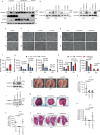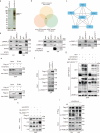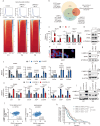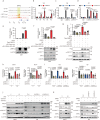L3MBTL3 and STAT3 collaboratively upregulate SNAIL expression to promote metastasis in female breast cancer
- PMID: 39747894
- PMCID: PMC11696420
- DOI: 10.1038/s41467-024-55617-9
L3MBTL3 and STAT3 collaboratively upregulate SNAIL expression to promote metastasis in female breast cancer
Abstract
The STAT3 pathway promotes epithelial-mesenchymal transition, migration, invasion and metastasis in cancer. STAT3 upregulates the transcription of the key epithelial-mesenchymal transition transcription factor SNAIL in a DNA binding-independent manner. However, the mechanism by which STAT3 is recruited to the SNAIL promoter to upregulate its expression is still elusive. In our study, the lysine methylation binding protein L3MBTL3 is positively associated with metastasis and poor prognosis in female patients with breast cancer. L3MBTL3 also promotes epithelial-mesenchymal transition and metastasis in breast cancer. Mechanistic analysis reveals that L3MBTL3 interacts with STAT3 and recruits STAT3 to the SNAIL promoter to increase SNAIL transcription levels. The interaction between L3MBTL3 and STAT3 is required for SNAIL transcription upregulation and metastasis in breast cancer, while the methylated lysine binding activity of L3MBTL3 is not required for these functions. In conclusion, L3MBTL3 and STAT3 synergistically upregulate SNAIL expression to promote breast cancer metastasis.
© 2024. The Author(s).
Conflict of interest statement
Competing interests: The authors declare no competing interests.
Figures










Similar articles
-
Hsa-microRNA-370-3p targeting Snail and Twist1 suppresses IL-8/STAT3-driven hepatocellular carcinoma metastasis.Cancer Sci. 2022 Dec;113(12):4120-4134. doi: 10.1111/cas.15571. Epub 2022 Oct 12. Cancer Sci. 2022. PMID: 36083239 Free PMC article.
-
A double-negative feedback loop between DEAD-box protein DDX21 and Snail regulates epithelial-mesenchymal transition and metastasis in breast cancer.Cancer Lett. 2018 Nov 28;437:67-78. doi: 10.1016/j.canlet.2018.08.021. Epub 2018 Aug 27. Cancer Lett. 2018. PMID: 30165191
-
MIER3 induces epithelial-mesenchymal transition and promotes breast cancer cell aggressiveness via forming a co-repressor complex with HDAC1/HDAC2/Snail.Exp Cell Res. 2021 Sep 1;406(1):112722. doi: 10.1016/j.yexcr.2021.112722. Epub 2021 Jul 6. Exp Cell Res. 2021. PMID: 34242623
-
COUP-TFII promotes metastasis and epithelial-to-mesenchymal transition through upregulating Snail in human intrahepatic cholangiocarcinoma.Acta Biochim Biophys Sin (Shanghai). 2020 Dec 11;52(11):1247-1256. doi: 10.1093/abbs/gmaa117. Acta Biochim Biophys Sin (Shanghai). 2020. PMID: 33166992
-
Snail/FOXK1/Cyr61 Signaling Axis Regulates the Epithelial-Mesenchymal Transition and Metastasis in Colorectal Cancer.Cell Physiol Biochem. 2018;47(2):590-603. doi: 10.1159/000490015. Epub 2018 May 22. Cell Physiol Biochem. 2018. PMID: 29794466
Cited by
-
Cancer stem cells and Lon-noncRNA promotes invasion, metastasis and tumor growth in breast cancer through regulation of signaling pathway.Sci Rep. 2025 Aug 8;15(1):29021. doi: 10.1038/s41598-025-13402-8. Sci Rep. 2025. PMID: 40781106 Free PMC article.
-
Irisin's Dual Role in Malignant Tumors and Its Potential as a Biomarker and Therapeutic Target.Drug Des Devel Ther. 2025 Aug 20;19:7185-7205. doi: 10.2147/DDDT.S532658. eCollection 2025. Drug Des Devel Ther. 2025. PMID: 40859977 Free PMC article. Review.
-
Transcriptomic and Functional Validation Reveals PAQR3/P6-55 as Potential Therapeutic Targets in Colon Cancer.Biology (Basel). 2025 Jun 27;14(7):780. doi: 10.3390/biology14070780. Biology (Basel). 2025. PMID: 40723340 Free PMC article.
References
-
- Zhou, B. P. et al. Dual regulation of Snail by GSK-3beta-mediated phosphorylation in control of epithelial-mesenchymal transition. Nat. Cell Biol.6, 931–940 (2004). - PubMed
-
- Barrallo-Gimeno, A. & Nieto, M. A. The Snail genes as inducers of cell movement and survival: implications in development and cancer. Development132, 3151–3161 (2005). - PubMed
Publication types
MeSH terms
Substances
Grants and funding
LinkOut - more resources
Full Text Sources
Medical
Research Materials
Miscellaneous

